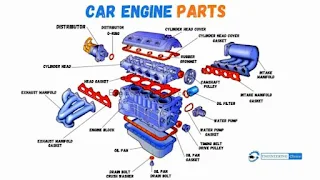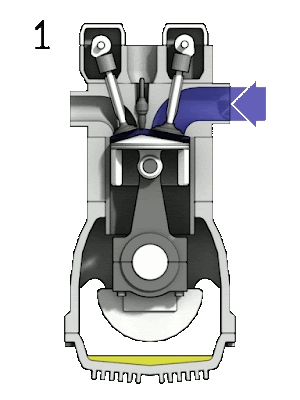How the Internal Combustion Engine Works: The 4-Stroke Principle
 |
| Engine Parts |
.jpeg) |
| Engine |
Introduction.
The internal combustion engine is the backbone of modern transportation, powering everything from cars and trucks to boats and airplanes. But have you ever wondered exactly how it works? The answer lies in the 4-stroke principle of the internal combustion engine. This principle is based on the four Strokes that occur within the Engine Working to create power: Intake, Compression, Combustion, and Exhaust. In this blog post, we'll be taking a closer look at how each of these four Strokes work to power the engine.
What is an Internal Combustion Engine?
Engine Working.
Engine working refers to the process of converting energy from a fuel source into useful mechanical energy for powering an engine. This can be done through a variety of ways, but most commonly it is achieved through the use of an internal combustion engine. Internal combustion engines are the most common type of engine and can be found in cars, trucks, boats, airplanes and even some bicycles.
Types of Internal Combustion Engines:
- Gasoline Internal Combustion Engines
- Diesel Internal Combustion Engines
- Two-Stroke Internal Combustion Engines
- Four-Stroke Internal Combustion Engines
- Rotary Internal Combustion Engines
But There are two main types of internal combustion engines according to Stroke :
two-stroke and four-stroke. Two-stroke engines are relatively simple and are often used in small machines such as lawnmowers, chainsaws and motorbikes. Four-stroke engines, however, are more complex and are typically used in larger machines such as automobiles and heavy machinery.
The four-stroke principle is the basis of how an internal combustion engine works. In this process, the piston moves up and down four times within the cylinder. During each stroke, the engine creates power to move the vehicle. These four strokes are the intake stroke, compression stroke, power stroke, and exhaust stroke.
The intake stroke starts when the piston moves downwards and the intake valve opens allowing air and fuel to enter the cylinder. This mixture then compresses at the top of the piston during the compression stroke. During the power stroke, the compressed mixture is ignited causing a rapid expansion of gases pushing down on the piston. The final stroke is the exhaust stroke, where the piston moves upwards and exhaust valves open allowing the gases to escape from the cylinder.
This four-stroke cycle is repeated over and over again creating a continuous flow of power that moves the engine. This process is what makes an internal combustion engine work, creating an efficient and powerful means of propulsion.
 |
| 4-Stroke Working Principle |
.jpeg) |
| 4-Stroke Working Principle |
The Four Strokes of an Internal Combustion Engine
The first stroke of an internal combustion engine is called the intake stroke. During this stroke, a mixture of air and fuel is drawn into the engine cylinder. The fuel-air mixture is then compressed in the second stroke of the engine’s working cycle, called the compression stroke. At this point, the air and fuel are both very highly pressurized, creating a high-pressure environment that is ideal for combustion.
In the third stroke of an internal combustion engine, called the power stroke, a spark plug ignites the fuel-air mixture within the cylinder. This sparks a controlled burn that creates a tremendous amount of energy, causing the piston to move downwards and the crankshaft to turn.
The fourth and final stroke of an internal combustion engine is called the exhaust stroke. During this stroke, the burned gases from the combustion process are expelled from the engine.
These four strokes create what is known as a “four-stroke engine”. This type of engine is found in most modern cars, trucks, and other motorized vehicles. When these four strokes work together, they create a powerful and efficient engine that can provide reliable and long-lasting performance.
Intake
The intake stroke is the first of the four strokes in an internal combustion engine working. During the intake stroke, air and fuel are drawn into the cylinder through an intake valve. The intake stroke starts with the piston at the top of its cylinder and the intake valve open. As the piston moves downwards it creates a vacuum, sucking air and fuel into the cylinder. This mixture of air and fuel is called the charge. The intake valve then closes, trapping the charge within the cylinder, ready for the next stroke.
Compression
The second step in the engine working process is compression. This is when the piston moves upward to compress the air-fuel mixture. During this stroke, the spark plug creates a spark that ignites the mixture, creating an explosion and forcing the piston back down. The timing of this explosion is crucial, as it helps to generate the power needed to move the vehicle forward. As the piston moves downward, it compresses the exhaust gases, which are then forced out of the cylinder.
Power
The third stroke of the internal combustion engine is known as the power stroke. During this stroke, the piston moves downwards, allowing for the combustion of fuel in the engine's cylinder. This combustion creates a tremendous amount of force, pushing the piston back up with great force and providing the energy needed to drive the engine. At this point, the engine has reached its peak power output, providing the engine with the necessary power to do its job. This power is what is used to propel a vehicle forward or rotate an axle in a machine. Engine working is only possible because of the power provided by the internal combustion engine.
Exhaust
The final stage of the internal combustion engine working cycle is the exhaust stroke. In this step, the piston moves up, pushing out the spent gases from the combustion chamber through the exhaust valves into the exhaust system. The exhaust stroke works to reduce the pressure in the combustion chamber so that it can be ready for a new intake stroke. The exhaust gases are typically recycled back into the air, depending on the type of engine.
Difference between Diesel And Petrol Engine
The two most popular types of internal combustion engines are diesel and petrol engines. They both use the same engine working principle, but there are a few differences between them. Diesel engines are compression ignition engines, meaning they use high compression to ignite the fuel-air mixture, while petrol engines are spark ignition engines, which rely on a spark to ignite the mixture.
Diesel engines have higher compression ratios than petrol engines, which means they generate more power per unit of volume. This allows them to achieve better fuel efficiency, making them ideal for larger vehicles. Diesel engines also require lower maintenance costs than petrol engines, due to the lack of spark plugs and other ignition components.
However, diesel engines tend to be noisier than petrol engines and can also produce more emissions. On the other hand, petrol engines produce more power per liter of displacement and offer better throttle response. They are also more suited for smaller vehicles, as their lighter weight and smaller size make them easier to maneuver.
Internal Combustion Engine Technology:
- Direct Injection Engines
- Turbocharged Engines
- Supercharged Engines
- Variable Valve Timing Engines
- Hybrid Internal Combustion Engines
- Lean-Burn Engines
Internal Combustion Engine Efficiency:
- Fuel Efficiency of Internal Combustion Engines
- Improving Internal Combustion Engine Efficiency
- Engine Compression Ratio
- Thermal Efficiency of Internal Combustion Engines
- Emissions Control in Internal Combustion Engines
Internal Combustion Engine Applications:
- Automotive Internal Combustion Engines
- Industrial Internal Combustion Engines
- Marine Internal Combustion Engines
- Aircraft Internal Combustion Engines
- Internal Combustion Engine Power Generation
Internal Combustion Engine Maintenance:
- Internal Combustion Engine Oil Change
- Internal Combustion Engine Maintenance Tips
- Common Internal Combustion Engine Problems
- Internal Combustion Engine Tune-Up
- Internal Combustion Engine Overhaul
Internal Combustion Engine Advancements:
- Electric Hybrid Internal Combustion Engines
- Alternative Fuels for Internal Combustion Engines
- Future of Internal Combustion Engines
- Internal Combustion Engine Innovations


.jpeg)
